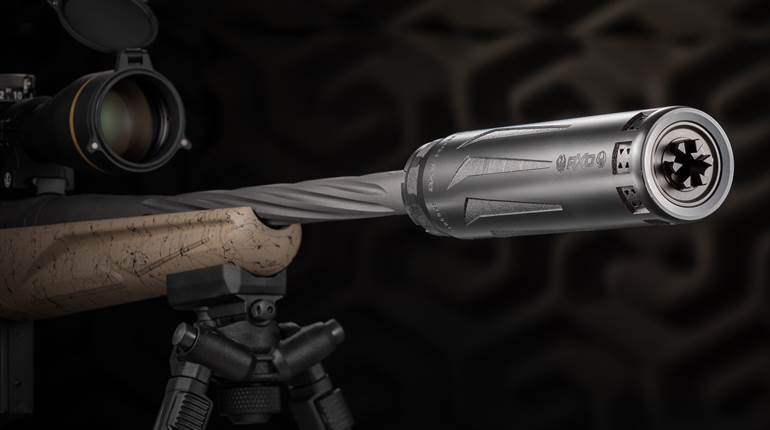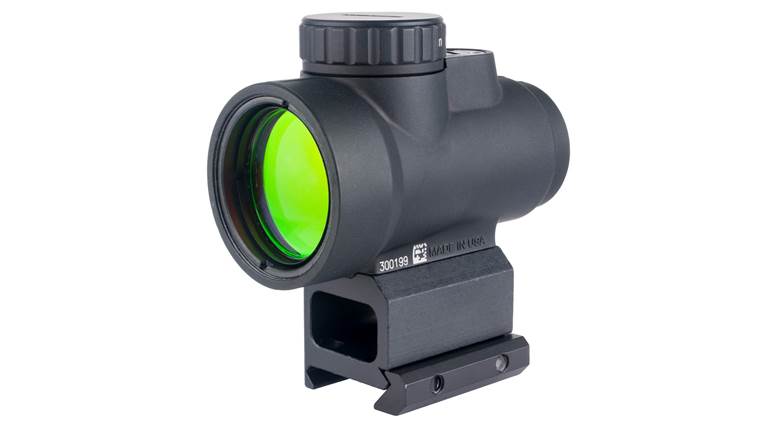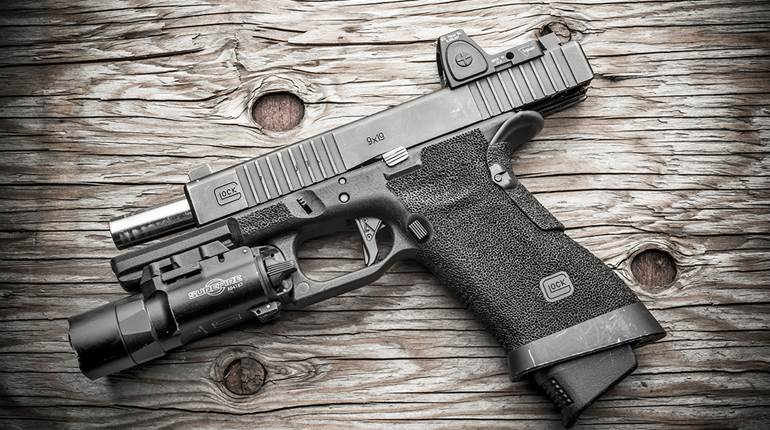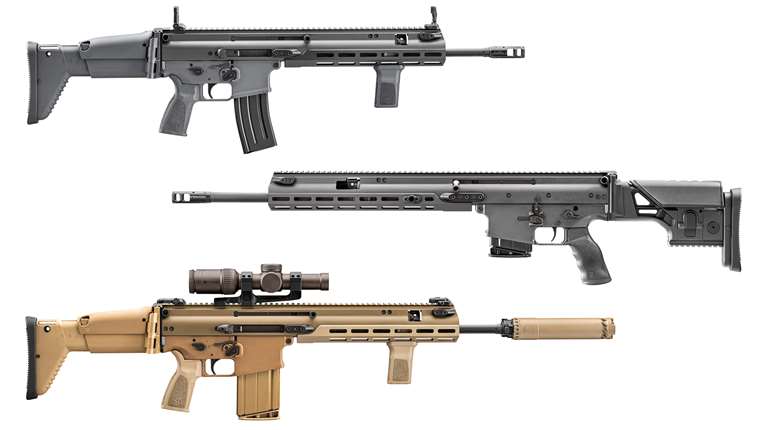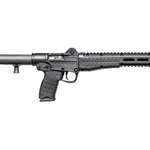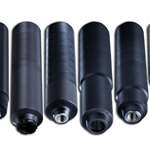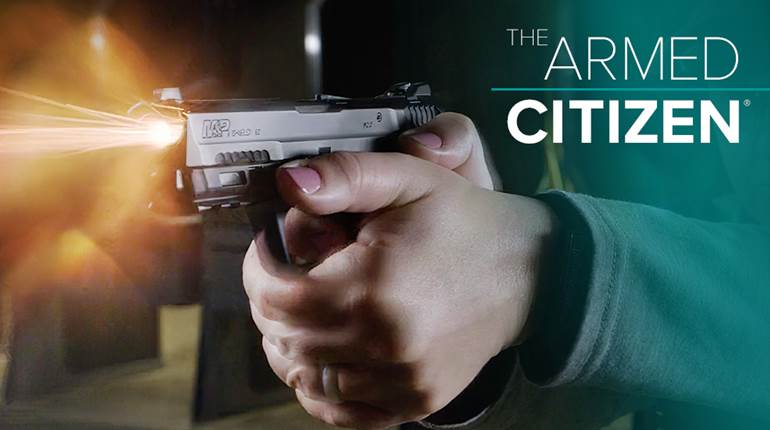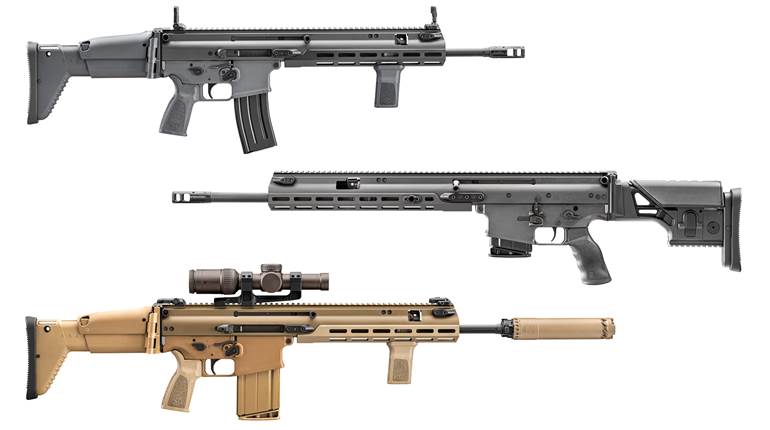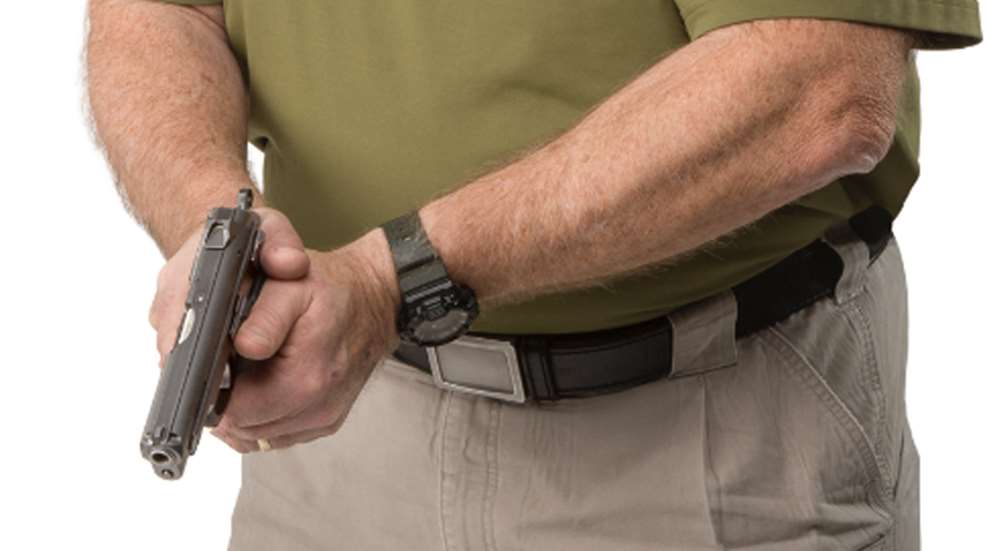
Criminals aren’t looking for a fair fight—most are cowards who prey on those they perceive to be easy targets, and, unfortunately, that often includes the elderly. According to the 2014 National Crime Victimization Survey, between the years of 2003 and 2013, persons 65 years and older were the victims of property crime an average of 1,796,740 times per year in our country, and they were the victims of violent crime 136,720 times annually. Making things even worse, studies indicate that elder victimization often goes unreported, and is therefore highly underestimated in crime statistics—meaning that the problem is likely even more prevalent than it appears.
So it’s an especially cruel irony that with advancing age also come a number of health issues that can make manipulating a firearm and defending oneself more difficult—complicating the use of the great equalizer for a group of people in particular need of it. But while time does march inexorably forward, and age-related physical changes are inevitable for all of us, there are ways to minimize their impact and work around them. I sat down recently with Joseph Logar, a doctor of physical therapy and the national manager of the NRA’s Adaptive Shooting Program (adaptiveshooting.nra.org), to discuss the realities of aging, and he offered up some helpful methods to both slow their progression and to circumvent their impact.
I’m going to warn you right off the bat, this article is not your typical American Rifleman fare. Much of what follows is diet and exercise advice with nary a gun review or historical account in sight—although there are some gear recommendations sprinkled throughout. I urge you to read on, however, as this guidance isn’t pertinent only to senior citizens. The preventative health tips outlined here are beneficial to everyone, regardless of age, and the equipment modifications listed below are applicable to any shooter who finds that he or she struggles, for any reason, to operate today’s modern crop of firearms. So stick around, one day you too will be elderly—if you’re lucky. But first, let’s start with a disclaimer: None of the information listed here should take the place of proper medical advice. Consult a physician before making any changes to your diet or exercise regimen.
“On a regular basis I encounter people who are either not carrying or not shooting entirely anymore due to their physical issues, and that’s really sad to me when there are options available that can help them work around their limitations,” said Logar. “When you find that your ability to effectively use a gun is being compromised, there are a number of things that can be done, including modifying your technique and modifying your equipment. This is not a dead-end street without hope.”
Logar identified three main age-related changes that typically affect our shooting: deteriorating vision, diminishing grip strength and arthritis. Although these issues can also complicate long gun use, their impact on the effective use of a handgun is particularly pronounced, which is why most of our conversation centered around pistols. Being a good health-care professional, Logar is a major advocate of proper diet and exercise, behaviors he includes under the umbrella of “modifying your technique,” and he recommends that we do everything we can internally to combat aging before resorting to a quick equipment fix to solve the problem.
“With very few exceptions, we can all benefit from strengthening our bodies—that needs to be the foundation of all your adaptations, with gear being secondary. Say you’re dealing with reduced grip strength, working on the muscles of your hand, arm and shoulder may make a gear adaptation completely unnecessary, while also benefitting you in other ways,” he said. “You can strap all the braces you want onto yourself, but you’re really not teaching your body anything by doing so, and you’re not helping yourself long-term. And while you might not always have all of your gear with you on the range, you always bring yourself.”
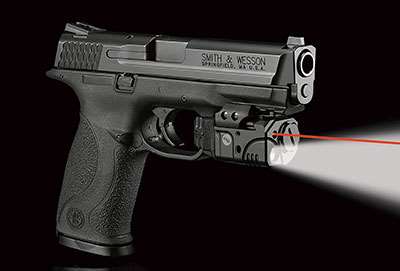
Deteriorating Vision
The ability to clearly see a gun’s sights (particularly the front post) is of paramount importance to shooters, and reconciling them quickly is vital to the successful defensive use of a handgun. The good news is that humans have been correcting vision for hundreds of years now, so we’ve developed a pretty solid background for doing so.
“The main thing we’re fighting vision-wise as we age is called presbyopia. You don’t think of eyes needing to be flexible, but they do, and as we get older our eyes become more dry and brittle and less able to transition to different distances as well,” Logar said. “For specific adaptations for your eyes, go to your optometrist, because they will be able to help you with your individual situation, and get eye exams every couple of years to stay on top of it.”
In addition to appliances such as glasses and contacts or corrective surgeries, diet and exercise play big roles in eye health. Most age-related vision changes are connected to oxidation and inflammatory conditions, making food and supplements rich in antioxidants and anti-inflammatories particularly beneficial. This means those high in Vitamins A, C and E, zinc, lutein and Omega-3 fatty acids. These nutrients work to insulate eye tissues from the day-to-day damage of UV light, while flushing away harmful cellular byproducts, and can slow the rate of vision loss in patients with age-related macular degeneration, retinitis pigmentosa and other illnesses.
Hydration is very important to our wellbeing in general, and our eyes are no exception, as well-lubricated eyes focus better, are more elastic and produce more protective tears. Doctors differ on exactly how much water we need to intake daily for maximum benefit, but eight, 8-oz. glasses (half a gallon) seems to be the floor posited by most experts.
According to Logar, regular exercise of any kind also benefits your eyes. “Every part of our body lives on blood supply, including your eyes, and getting your blood pumping a couple of times a day will help rejuvenate your eyes—even if you’re just working out your legs,” he said. The doctor identified smoking as particularly harmful for eye health, as it both restricts blood supply and dehydrates the body, and also named ultraviolet light exposure and avoidable trauma (always wear that eye protection) as other modifiable risk factors.
All is not lost, however, for those already suffering from declining vision, as there are some firearm modifications that can make a difference for aging shooters. A black-on-black sight picture is very difficult to acquire for someone struggling with presbyopia, but upgrading to a set of high-contrast/high-visibility sights can make a tangible difference. Options include XS Sights’ DXT/DXW lines, SIG Sauer’s X-Ray3 or TruGlo’s TFX Pro offerings.

In much the same vein, a glowing red (or green) aiming dot can be a real boon to the elderly defender, whether it be transposed onto the target by a slide-mounted optic such as Trijicon’s RMR, Leupold’s DeltaPoint Pro or Bushnell’s First Strike 2.0, or projected by a laser sight. Opting for the latter will likely save you some money, which is important for those on a set income. Crimson Trace, Viridian and LaserMax all offer both handgun-specific models (Lasergrips/Laserguard, E Series, GripSense) and universal, rail-mounted products (Rail Master, X/C Series, Spartan/Uni). Fortunately, many, if not most, modern holster makers offer versions of their products that can accommodate the presence of micro reflex sights and/or frame-mounted laser modules.
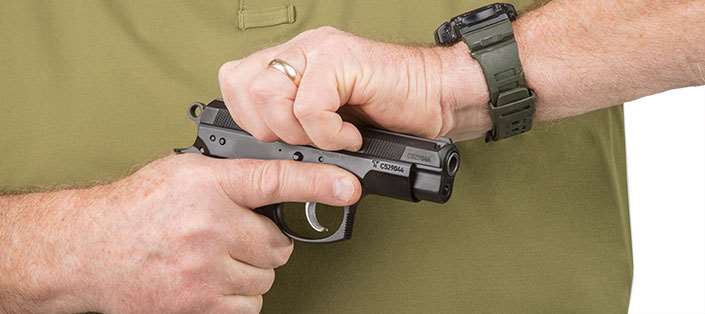
Decreasing Grip Strength
We use our hands constantly, day-in and day-out, usually without giving it much conscious thought, and over the course of a lifetime all that wear and tear adds up. The grip strength of our hands diminishes with age (more precipitously in men than in women) and, from a practical standpoint, this can eventually impact a shooter’s ability to manage recoil and manipulate the firearm’s controls—with racking the slide on a locked-breech semi-automatic pistol becoming especially problematic.
What advice does Dr. Logar provide for those struggling with a dearth of grip strength? Don’t skip hand day, for starters. He recommends hand-strengthening exercises, such as making and holding a fist and squeezing a soft ball, but also warns to be careful to avoid doing only exercises that focus on the closing of the hand. Hand-opening exercises, such as doing finger lifts, are also important, and submerging your hand within a bucket of sand and opening it against resistance is a creative way to work these muscles.
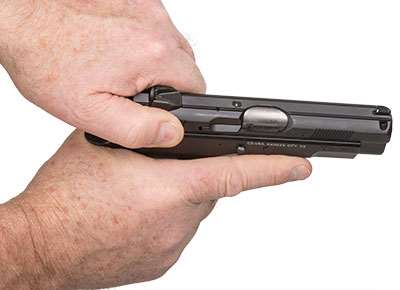
According to Logar, getting quality firearm training is also vital to aging defenders, as doing things the right way is a lot less stressful on our bodies than doing it the wrong way, and proper body mechanics are of particular importance as we age and our bodies weaken. A prime example can be seen in how one racks a slide. Pinching the slide between the thumb and the index finger relies almost exclusively on the muscles of those two small fingers, while an overhand grasp that allows the shooter to employ a push-pull technique makes use of not only the muscles of the entire hand, but also the shoulders and chest.
“We are made, structurally, to work in a specific way. When you’re young and strong and your joints are good, you can get away with not doing things the right way,” Logar said. “But as your body weakens, it’s more important to get back to that ideal structure.”
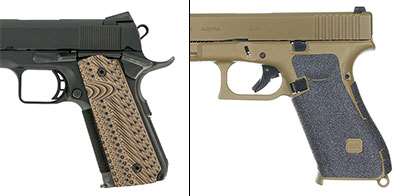
A number of things can be done, on the equipment side, to help mitigate declining grip strength. If you’re finding it harder to hold onto your handgun during recoil, options include adding texturing to the firearm, installing a recoil-reducing device to the muzzle and having a gunsmith add porting to the barrel and slide. Logar confirmed that we generally become more recoil-sensitive with age, and stepping down to a less-energetic chambering (or even just load) is always an option—a hit with a .380 ACP being worth infinitely more than a miss with a .45 ACP. Conversely, for those whose health allow it, stepping up to a larger, heavier gun will also help tame recoil.
Texturing can be permanently added to polymer-frame firearms by having a professional stipple the grip area to create a more aggressive surface, and to metal-frame guns by having the backstrap and/or the frontstrap checkered or serrated. However, added texturing can also be applied on a temporary basis (for far less money) through the use of grip sleeves such as Pachmayr’s Slip-On Grip line and Talon Grips’ adhesive wraps, or by the installation of either coarser (think sharply patterned G10 or wood) or tackier (think rubber) stock panels. Compensators can make a huge difference recoil-wise, just be aware of the extra length, weight and snagability that they add to the gun.
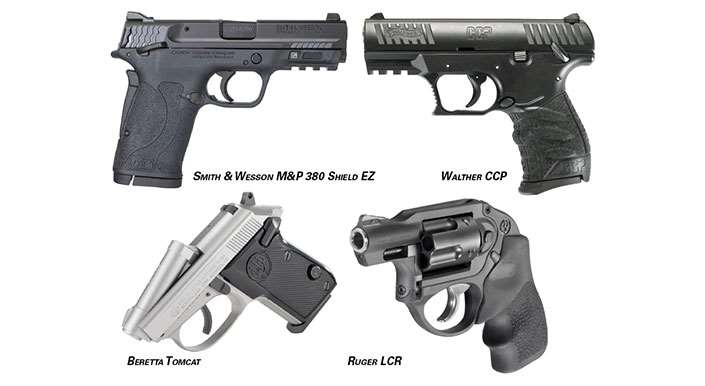
Accessory charging rings (such as the Brass Stacker Slide Pull and the TandemKross Halo) provide a secure loop from which to pull the slide rearward, and are made to accommodate a number of handgun models. However, they significantly increase the length of the slide and may be impractical for concealed carry in some cases. Those still experiencing great difficulty manipulating the slide of the average semi-automatic may want to try out the Smith & Wesson M&P 380 Shield EZ or the Walther CCP pistols specifically—two pistols designed expressly around easy-to-rack slides. If neither of those options appeal to you, a tilt-barrel design such as Beretta’s Tomcat allows you to load a round directly into the chamber, so that you never need to manually rack the slide. And, last but certainly not least, the wide world of revolvers dispense with the slide entirely, making wheelguns viable options for those of compromised grip strength—although the heavier trigger pulls associated with double-action models must also be taken into consideration.
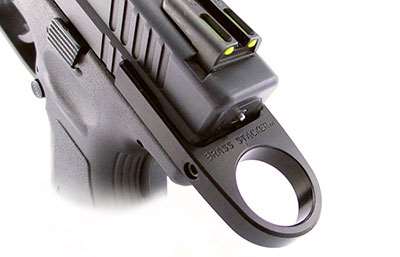
Arthritis
According to the Centers for Disease Control and Prevention, 54.4 million Americans have been diagnosed with some form of arthritis, defined on a basic level as joint inflammation, a problem that gets progressively worse with time. For many, arthritis can attack the joints of the hand particularly severely—the most common location for arthritis throughout the entire body being the thumbs—rendering simple actions more difficult and painful, and working synergistically with the diminished grip strength mentioned above to potentially make things really miserable for aging defenders. For an arthritis sufferer, Logar likened gripping a pistol with “holding the handle of a jackhammer wrapped in barbed wire.”
Arthritic hands can struggle especially with fine motor control, such as many of the actions needed to load a handgun or operate a small control like a slide stop—or even pull a trigger. The doctor said virtually all adults have some degree of arthritis, it is just subclinical for most of us, and that preventative care when we’re younger can make a major difference to our joint health down the road.
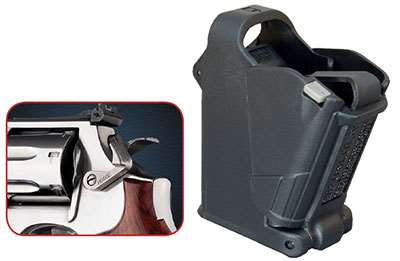
“Take care of your joints when you’re younger, and they will take care of you when you’re older. If you get a strain, treat it immediately; ice it in the evening and give it rest,” he said. “You’d be surprised how much difference it will make in the long run if we take care of things properly now.”
But what can be done once debilitating arthritis has already set in? Yet again, exercise is the best answer. The inflammation and pain of arthritis are often the result of asymmetrical or disproportional pressures placed on the joint. Exercise, performed correctly and at the proper stage for the type of arthritis in question, can help balance the load by creating stronger and more flexible muscles to better support the joint.
“There’s a long history of effectively using exercise to treat arthritis. Keep the impact down—if you know you have arthritis of the knee then obviously don’t start with running long distances,” Logar said. “However, starting with swimming or biking allows you to build your body up slowly without beating your joints up further.”
Generally speaking for those with arthritis, the smaller the diameter of the object being grasped, the greater the demand on the joints of the hand to generate motion, and the greater the pain as a result. By switching to a gun with a larger-diameter grip—or utilizing the replaceable-backstrap systems common among modern polymer-framed handguns to increase the circumference on the firearm you’re already using—you can decrease the range of motion necessary to grasp it. Grip sleeves help in this regard as well, adding surface area in a manner that is quick, inexpensive and reversible.
In terms of gear, arthritis of the hands can be tricky to circumvent, but there are some options. Arthritic hands struggle mightily with the task of loading a detachable box magazine, and magazine loaders such as Maglula’s UpLULA are a godsend for those afflicted. Revolver shooters may likewise struggle to activate some cylinder latch designs, and products such as Hogue’s Extended Cylinder Release can provide assistance—but run the increased risk of snagging on clothing.
It can also come down to identifying and either avoiding or replacing specific controls that give you grief. Logar mentioned, in particular, that the tiny contact surfaces on the “slide lock” (takedown lever) of Glock pistols (and other similar designs) can be very difficult for arthritic fingers to work. So, in that case, an aging defender could either choose a different handgun make with a less problematic fieldstripping process, or else install an extended aftermarket part such as that offered by NDZ Performance.
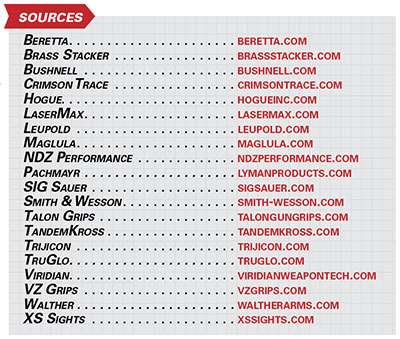
Conclusions
We are all individuals, so your mileage will almost certainly vary. For those already within the grip of age-related physical decline, some of you may suffer from one of the above symptoms far more than the others, while some may be tackling all three simultaneously. As a result, what works well for you might not help me at all—the light, crisp break of the 1911 platform may make it a great choice for those whose arthritis makes pulling a trigger a chore, but it’s particularly hard-to-rack slide is no friend to those with a lack of grip strength. The information listed above is far from exhaustive, but hopefully it was enough to provide some direction in helping you determine which health and equipment changes might be most effective for you.
Still a few years shy of 40, I already have a multitude of creaky joints and depressingly thick Coke-bottle glasses. And I’m sure I’m not alone when I say that I’m more than a little concerned by the prospect of either of those issues continuing to progress to the point that, at some time in the future, I can no longer engage in my favorite hobby or even defend my loved ones. But speaking with Dr. Logar gave me hope that, by doing what I can now to proactively mitigate the effects of aging, that day may not ever have to come.












